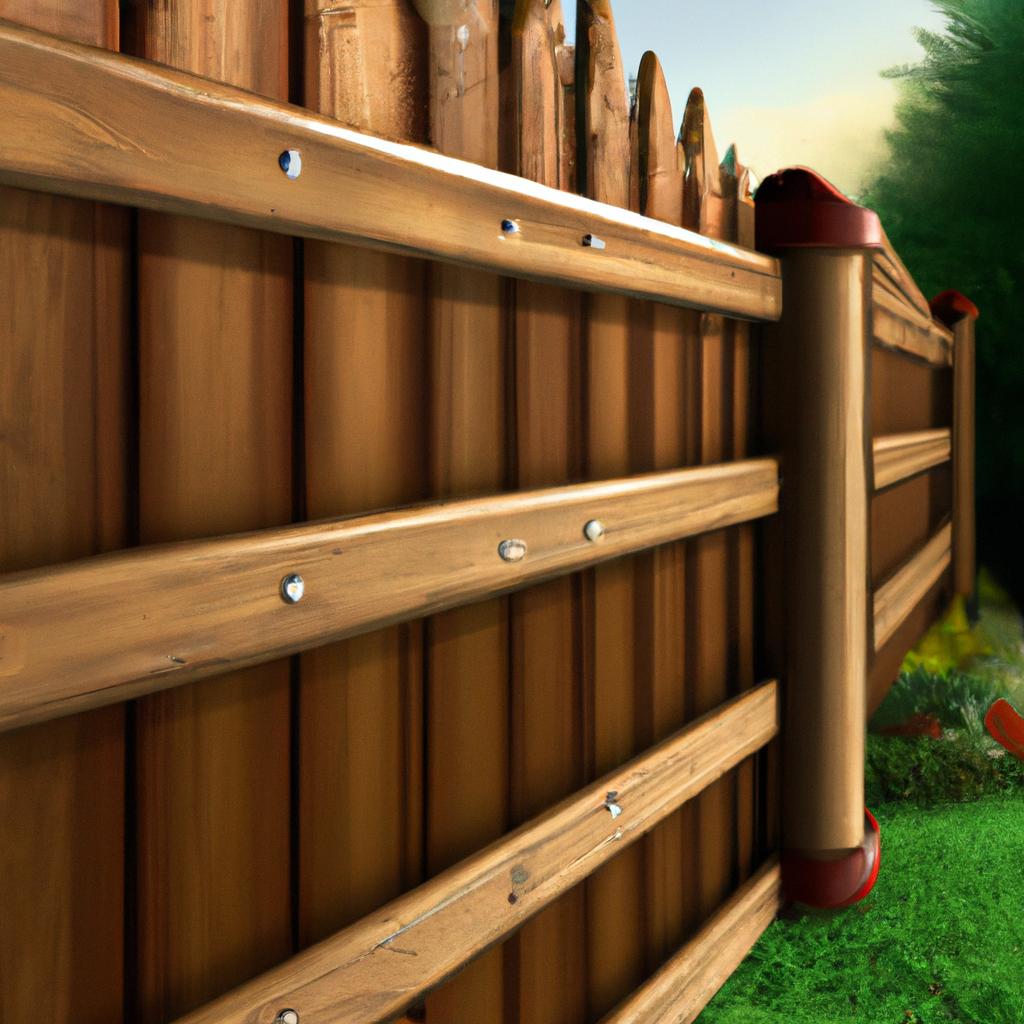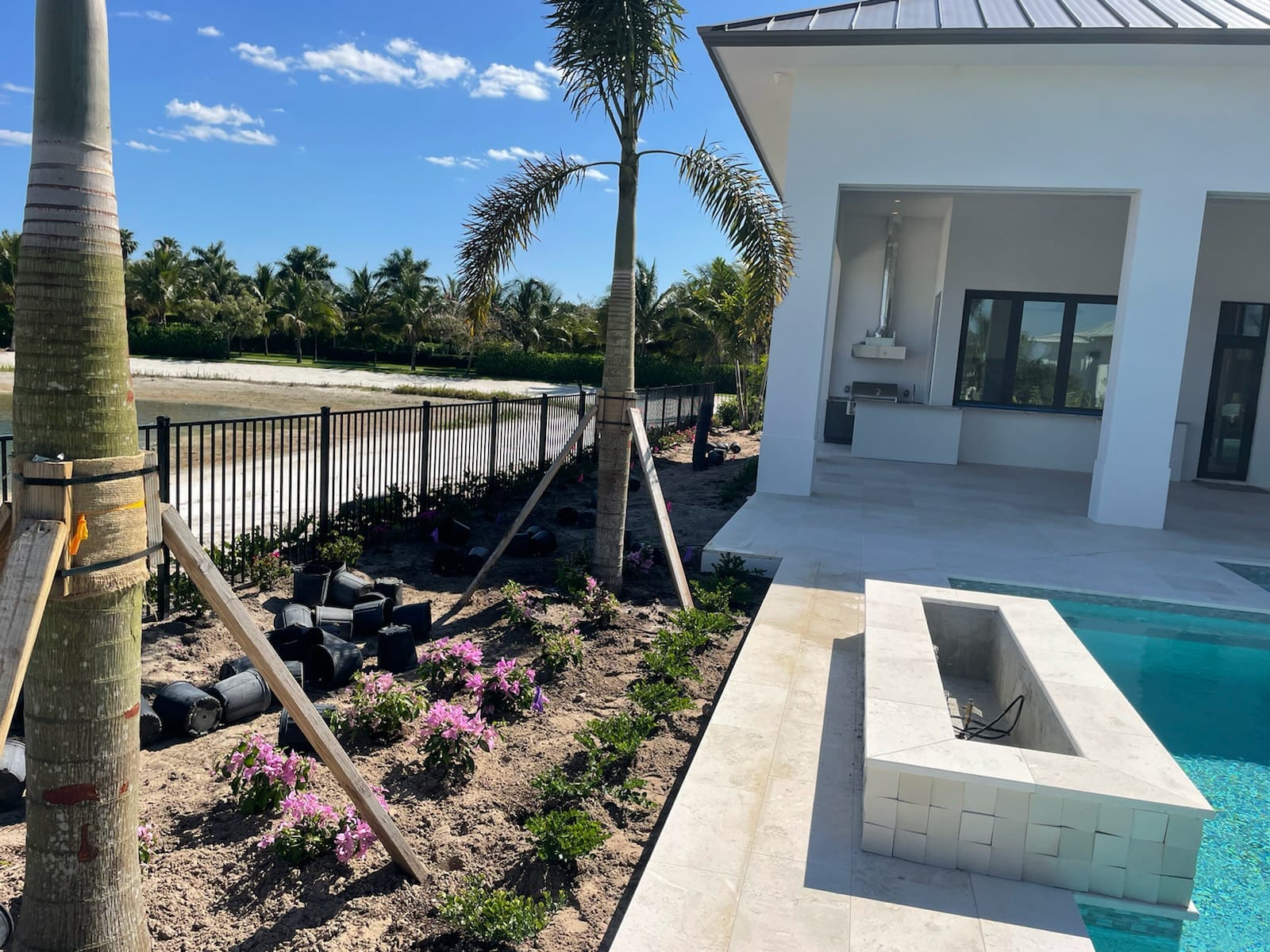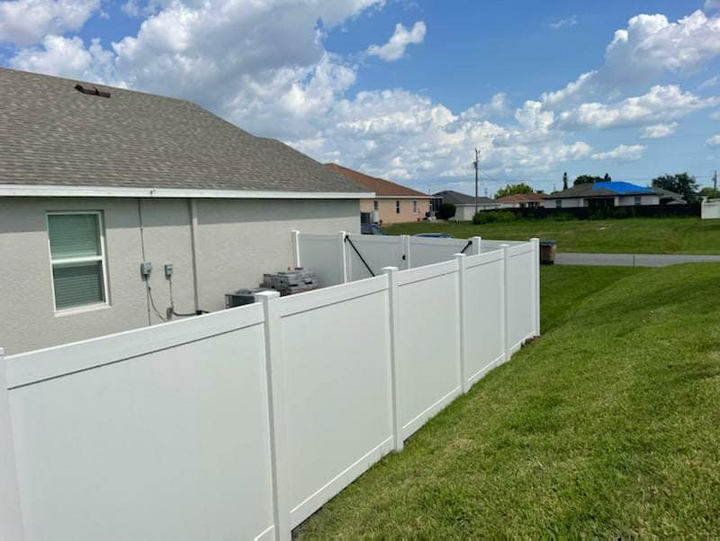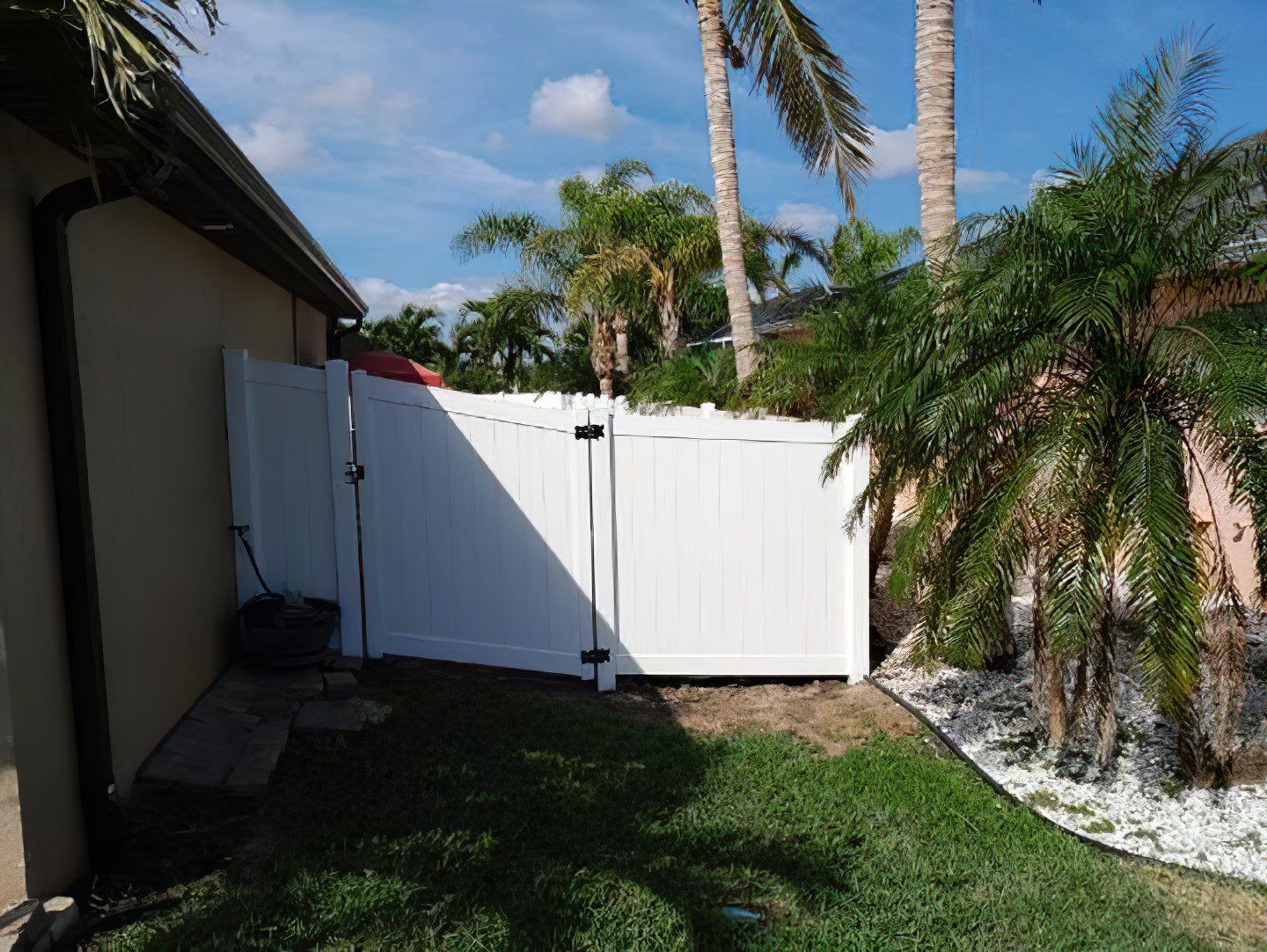Garden fencing is pivotal in yard design, serving practical and aesthetic purposes. It defines property…

What is the cheapest most durable fence – Dolphin Fence Corp
Introduction to the concept of a cheap yet durable fence
A sturdy and affordable fence is a great idea! We have the solutions.
Wooden fences are the cheapest, but not so durable. Chain-link fences are more durable but don’t look great.
Vinyl-coated chain-link and aluminum fences offer durability and affordability. To further increase longevity, use galvanized steel poles instead of wood posts on budget-friendly chain-link fences.
Why settle for barbed wire? Get the newest recycled toilet seat fence materials!
Types of fencing materials
To help you find the most durable yet cheapest fence for your property, this section will discuss the different types of fencing materials such as wood, vinyl, chain-link, aluminum, and iron. Knowing the benefits and drawbacks of each sub-section will guide you in making a better decision for your fencing needs.
Wood Fencing
Wood is an iconic fencing material that has been around for centuries. Its natural beauty and durability make it a great choice for many homeowners.
Things to consider when choosing a wooden fence:
- Types of wood available, like cedar, redwood, and pine
- Maintenance is necessary to keep the fence looking good and lasting longer
- Staining or painting must be done regularly to avoid discoloration
The type of wood impacts the amount of maintenance needed; some woods are more robust than others.
Before settling on a wooden fence, think about the climate of your area. Excessive rain, snow, or humidity can cause damage over time. With proper maintenance, wood fences can last longer than other materials.
An owner had an unfortunate tale of his wooden fence being eaten by termites. He was devastated by the cost of repair, but he didn’t want to give up on such a reliable material. He opted for annual inspections with professional pest control services to avoid further damage.
Vinyl fencing is an excellent alternative if you want to go for the white picket fence look and skip the rusty wire nightmare.
Vinyl Fencing
Vinyl fencing is a great option for homeowners. It comes in a variety of colors and styles, including wood-look vinyl. It’s resistant to moisture, insects and UV rays, and is easy to clean – just use soap and water. Plus, it’s environmentally friendly, since it doesn’t require chemical treatment.
Installation is relatively easy, making it cost-effective in the long run. It’s also lightweight and can withstand some force, making it a suitable choice for privacy or safety fences. With decorative elements like lattice patterns or finials, you can maximize your investment for an aesthetic look.
Chain-link Fencing
The ‘diamond wire mesh fence‘ is a highly durable and flexible fencing option, perfect for both residential and commercial properties. Its interlocking diamond pattern offers superior strength. Plus, they’re low-maintenance, giving you peace of mind. And they come in various colors and coatings to fit any aesthetics. Not to mention, they’re budget-friendly too!
Plus, you can add barbed wires or slats to make your fence more private. So, if you’re looking for an effective and affordable security solution, why not consider a chain-link fence? It’s a simple solution that offers exceptional durability and peace of mind. Get yours today!
Aluminum Fencing
Aluminum is popular in the fencing industry. Its wide applicability, sleek design and low maintenance make it stand out. Plus, there’s a range of colors and shapes to choose from.
Aluminum is perfect for coastal regions – it resists water and won’t rust. It’s easy to install, and the panels fasten to posts or traverse rail brackets.
Premium-Quality aluminum is coated with powder, making it highly durable and resistant to fading in extreme weather.
Opting for aluminum fencing adds security, privacy and boosts the value of your property – like a superhero’s suit, but without the superpowers!
Iron Fencing
Iron fences can be made to fit any design or size. Little upkeep is needed, but they have to be painted occasionally. They also give a good view of the area around. Even though the starting cost is high, they last longer.
Though iron fencing has been replaced by other materials because it is costly to install and maintain, it can still make your property look nice if you take care of it.
For example, a homeowner in the countryside chose an old-style iron fence for their Victorian home renovation project, which added character to the place.
The cost of a fence may vary, but it won’t prevent the neighbour’s child from kicking their soccer ball over it.
Comparison of Fence Costs
To compare fence costs of various materials, like wood, vinyl, chain-link, aluminum, and iron, as a solution to your fence-buying dilemma, we present this section. Each sub-section will discuss the cost of one type of fencing. You’ll learn which is the most cost-effective in the long run and which fence may add more value to your property.
Cost of Wood Fencing
Wooden Fencing costs can vary. Here’s what to know when assessing the expenses:
- Wood type, height, and length: These are the three main factors that impact the cost.
- Labor: Who you hire and their expertise affects installation costs.
- Maintenance: Regular staining or painting must be done to ensure the fence lasts.
- Surrounding features: Clearing trees or hills takes more time and money.
- Location: Wood type and labor costs are affected by where you live.
It’s important to remember that wooden fencing provides privacy and a great outdoor look that adds to property value. Investing in a quality fence now avoids costly repairs later.
Planning ahead is the best way to go when it comes to wooden fencing projects. Vinyl fences may be expensive, but they’re worth it!
Cost of Vinyl Fencing
Vinyl fencing is a top pick for its sturdiness and low upkeep. To give you a sense of the expense of this type of fencing, we have made a table with info on the normal costs every linear foot.
| Type of Vinyl Fence | Average Cost Per Linear Foot |
|---|---|
| Privacy | $28 – $42 |
| Semi-privacy | $22 – $32 |
| Picket | $21 – $31 |
| Ranch | $19 – $28 |
Note that the total cost of vinyl fencing will rely upon elements like fence height, color, and ornamental highlights. In any case, the above table gives a decent beginning stage for budgeting your vinyl fence venture.
When pondering vinyl fencing, remember to include the extra expenses of installation, permits, and any essential extras like gate equipment or post caps.
HomeAdvisor reveals that introducing a vinyl fence typically costs between $2,765 and $6,189.
Chain-link fencing: In case you’re looking to keep out unwelcome visitors… or neighbors.
Cost of Chain-link Fencing
Analyzing the Cost of Chain-link Fences
Chain-link fences are popular. They’re tough and low maintenance. We’ve put together a cost breakdown for these fences.
Here’s the average cost per linear foot for fences of different heights. This includes materials and installation. Prices may differ depending on where you live.
| Fence Height | Average Cost |
|---|---|
| 4 feet | $8-$18 |
| 6 feet | $10-$22 |
| 8 feet | $15-$35 |
You may face extra costs for gate installation or fence removal. Get quotes from reliable contractors before making a choice.
Pro Tip: Invest in high-grade materials such as galvanized steel. They’re more expensive, but you won’t have to worry about rust or your neighbor’s dog chewing it up.
Cost of Aluminum Fencing
The expenses for aluminum fencing vary greatly. It depends on things like the type, length, height and complexity of installation, plus any accessories you may need. Residential grade averages $22-$32, and Commercial grade averages $24-$36 per linear foot – excluding installation.
Iron fencing is out! Instead, why not build a moat filled with angry geese? Aluminum fences cost more than wooden ones, but last longer and require minimal maintenance. Plus, you can choose different colors or finishes to influence the cost.
Pro Tip: Get a professional opinion before making a final decision on an aluminum fence. Different types suit different situations – don’t miss out!
Cost of Iron Fencing
Iron fencing cost comparisons can be overwhelming. Wrought iron, aluminum, and steel are popular choices for homes and businesses due to their durability and looks. Here’s a breakdown of their prices per linear foot:
- Wrought Iron: $25-$30+
- Aluminum: $20-$25
- Steel: $30-$35+
When selecting, remember higher quality materials may cost more upfront, but can save you money in the long-run. Also, selecting a reliable contractor for installation can help avoid future maintenance costs. Lastly, research local codes and regulations, as some areas have specific requirements for height and design.
Remember, fences and relationships require maintenance to stay strong and keep out the unwanted.
Comparison of Fence Maintenance Requirements
To compare the maintenance requirements of different fence types, you need to weigh the pros and cons of each material to determine the best option for you. In this section, we will discuss the maintenance requirements of wood, vinyl, chain-link, aluminum, and iron fencing. Understanding how each of these materials ages and responds to weather conditions will help you choose the most cost-effective and durable option for your property.
Maintenance Requirements of Wood Fencing
Wood fences need regular upkeep to ensure their lastingness and their look. Here’s the details of what’s needed for wooden fences:
- Cleaning with soap and water regularly.
- Check for harm, rot, or decay.
- Staining or painting to guard the wood from weather.
- Cutting plants around the fence to stop moisture staying.
- Sanding rough spots and repainting or staining.
- Using bug repellent to keep pests away, like ants and termites.
It’s vital to remember that improper care can cause harm and cost a lot to fix in the future. It’s also essential to ask experts for advice on the right products to use.
To keep a wooden fence in good shape, one must pay attention to particular details like inspecting hinges, latches, screws, and bolts for any loose parts. These checks must be frequently done if we are determined to secure our fencing.
A friend of mine didn’t do regular fence maintenance and had to pay a lot for repairs as the fence was rotting. Now she has a service to look after the fence, which has made it more durable over time. Vinyl fences may not need much maintenance, but nothing is truly free of maintenance apart from maybe a rock. And even then, that has to stand up against erosion.
Maintenance Requirements of Vinyl Fencing
Vinyl fencing needs regular upkeep. Cleaning, servicing and inspection for damages are all musts to prevent discoloration, cracking or warping from harsh weather.
Wash with soap, check for damage and repair. Remove debris, mold and dirt. Use professional-grade cleaners to clean without damaging the material. Gently scrub away built up dirt.
Improper installation can lead to future maintenance problems. Get a professional service to install vinyl fences. Check spacing between posts and panels are cut properly.
Vinyl fences first appeared in the 1960s as a low-maintenance alternative to wooden fences. Now, they come in various types and need different upkeep. They remain known for their durability, resistance, energy efficiency and extended lifespan compared with other fence types. So, why maintain your chain-link fence when you can just embrace the rustic-chic look?
Maintenance Requirements of Chain-link Fencing
Chain-link Fencing needs regular maintenance to make sure it’s long-lasting and effective. Check the fence for any damages or weaknesses. Clean it with soap, water, and a soft brush. This will remove dirt, rust, and other buildups. Put on a rust-resistant coat to stop corrosion and make it last longer.
Paint or coat it regularly to keep it looking new and prevent rusting. Inspect the bottom for rust at least once a year. This stops structural failure. Test the tension too. This prevents sagging caused by things like temperature and wind.
Watch out for nearby trees. Overhanging branches can damage chain link fencing.
Chain-link Fencing has been around for centuries. It was first used in England in 1844 for military purposes. In 1891, it was used commercially in America. By World War II, petrol rationing from steel shortages caused development of other materials. Nowadays, chain link fencing can protect against any threat! Aluminum fences are low maintenance, high security, and perfect for keeping nosy neighbors away.
Maintenance Requirements of Aluminum Fencing
Aluminum fencing is perfect for homeowners wanting a visually appealing and efficient fence. Here are six maintenance steps to help your aluminum fence stay long-term:
- Rinse the fence with a hose to remove dirt and debris.
- Use mild cleaners or household detergents to remove any stains.
- Do not use abrasive scrubbers or harsh chemicals as they may damage the finish.
- Lubricate locks and hinges regularly to keep them in top condition.
- Check often for signs of rust, which may indicate underlying issues.
- Make any necessary repairs straight away.
Aluminum fences are also great at withstanding harsh weather conditions. My neighbors had their fence installed last year and were amazed at how easy it was to maintain. Plus, it looked great! Even the toughest criminals will be taken aback by rusty iron fencing.
Maintenance Requirements of Iron Fencing
Iron fencing maintenance: It’s essential to take care of durable, lasting fences. Iron fences are tough, but you need to take preventive steps to keep them in top condition and make them last. Here are some tips to help:
- Check for rust – Inspect the fence regularly to spot any rust. Rust can weaken the fence and eventually cause it to collapse. Use a rust remover to get rid of it.
- Get professional cleaning – Professional cleaning every once in a while helps the fence look better and prevents dirt build-up, which can corrode the paint.
- Paint – Painting is great for taking care of an iron fence. Do a full sandblasting before applying oil-based paint for a long-term solution.
Check gates closely too, as they tend to wear out faster.
Pro Tip: Regular checks and minimal upkeep ensure you stay safe and avoid costly repairs in the future. Invest in a durable and affordable fence now and save on security guards!
Best Fencing Option for Durability and Affordability
To find the best fencing option that is both durable and affordable, consider the advantages and disadvantages of popular fencing materials. Wood fencing may be a popular choice, but it comes with its own set of pros and cons. Vinyl, chain-link, aluminum, and iron fencing each have their own set of benefits and drawbacks. By understanding each of these options, you can make a more informed decision about which fencing material is best for your needs.
Advantages and Disadvantages of Wood Fencing
Wooden Fencing: Benefits and Downsides
Wood fencing is a popular choice. It adds aesthetic value. But, like all things, it has its pros and cons.
- Advantages:
- Wood fencing is cheaper than other types.
- Wood is easily available.
- It looks classic and enhances a property’s beauty.
- You can customize the structure.
- A well-built wooden fence can last over two decades.
- Disadvantages:
- In humid climates, you may need to replace or modify parts regularly.
- You’ll need to paint and stain, which increases costs.
- Insects and pests can damage wood easier than vinyl or metal.
You need to be responsible with maintenance, paint, and repairs. Otherwise, any material used for renovation projects will decline. So, invest wisely! Vinyl fencing may be low-maintenance but it’s still high-maintenance compared to not having a fence.
Advantages and Disadvantages of Vinyl Fencing
Vinyl fencing is popular because it’s strong and cost-effective. Let’s take a look at its advantages and disadvantages.
- Flexibility: Looks just like wood or picket fences. Perfect for every homeowner.
- Low upkeep: Cleaning vinyl fences is easy. Plus, it won’t rot, warp or splinter.
- Environmental worries: Vinyl is not recyclable yet. It can waste resources.
But, it expands and contracts with extreme temperatures, causing tiny cracks. Its benefits outweigh the risks.
Pro Tip: Get high-quality materials. Poorly made or installed ones can wear quickly.
Chain-link fencing: The ideal choice for keeping your pup in, and your nosy neighbours out.
Advantages and Disadvantages of Chain-link Fencing
Chain-link fencing offers a few perks, as well as some drawbacks. Here are the pros and cons of using chain-link for your property:
- Pro: Durability – Chain-link fences are constructed from galvanized steel, meaning they can withstand extreme weather conditions like snow, wind, and rain.
- Pro: Affordability – Chain-link is cheaper than other types of fences.
- Pro: Low-maintenance – They don’t need much upkeep after installation.
- Con: Limited Privacy – The spaces between wires don’t offer much privacy.
- Con: Unattractive – Chain-link isn’t known for its looks.
- Con: Susceptible to cutting – Intruders or animals could easily cut through the interconnected wires.
It’s important to note that chain-link fencing comes in various gauges, so it’s essential to pick the right one for your needs. Despite certain drawbacks, chain-link fencing remains a cost-effective and durable choice.
When installing a fence, the type of soil is also a factor. Chain-link posts need more cement footing than wooden posts because they have less contact with the ground.
In the past, during WWII, chain-link was used to construct concentration camps. This has left an unfortunate mark on the reputation of chain-link, but as tensions have eased, suspicions of this association have decreased. So, if you’re looking for a lightweight, durable fence that can handle a backyard wrestling match, aluminum fencing is the perfect choice!
Advantages and Disadvantages of Aluminum Fencing
Aluminum fencing is a great option for those seeking durability and affordability. It won’t rust or corrode, plus it’s low maintenance.
But the construction quality may vary across different brands. So, make sure you check it out before you buy!
Also, customizing your aluminum fence can be pricey. But if you’re after certain colors or design elements, it may be worth it.
Iron fencing is an alternative – both secure and cost-effective!
Advantages and Disadvantages of Iron Fencing
Iron fencing: Pros and cons.
Advantages of Iron fencing:
- Durable & long-lasting.
- Better security & privacy.
- Classic, stately look.
- Low maintenance & high resistance.
- Endless customization possibilities.
Disadvantages of Iron fencing:
- Heavy installation & expensive upfront.
- Rust formation over time due to moisture.
- Prone to corrosion if not painted.
- Vulnerable to extreme weather.
- Sharp edges a safety concern.
Also need specialized tools while installing. Protective coatings & treatments help but may wear down in moist conditions. My family friend had this problem with their pool fence. Even with painting services, he switched over.
If you want durability & customization, Iron fencing is a good option. But invest time & money into upkeep for best results. Upgrade your home’s security & value with these fencing options.
Best Fencing Option for Property Value
Choosing the right fence is essential to maximize property value with minimal cost. We’ve gathered some of the most durable yet affordable fencing options to save you hassle. Check out the table below to get started!
| Fencing Option | Cost per Linear Foot | Maintenance Cost | Durability (Years) |
|---|---|---|---|
| Chain Link Fence | $5-$20 | Low | 20-25 |
| Vinyl Fencing | $20-$35 | Low | 30-40+ |
| Bamboo Fencing | $6-$10* | No upkeep needed | 10+ |
Chain link fences are cheap, protecting your property well but might not be too pretty. Vinyl fencing is a bit pricier than chain link fences, however, it lasts longer and looks better. Bamboo fence is eco-friendly, attractive and requires no maintenance, however, its durability is lower than the other two.
Factors such as location, contractor fees, and extra features may affect the prices. HomeAdvisor states that installing a fence can increase property value by an average of $1,700. Just make sure that the cost won’t outweigh the benefits! Even if I don’t have kids, my fence is strong enough to keep my pets in and my neighbor’s annoying dog out.
Best Fencing Option for Pet Owners
Pet owners want affordable, durable and safe fencing for their furry friends. With numerous styles and materials to pick from, it can be overwhelming. Here’s a look at the best pet-friendly fencing options:
- Aluminum Fences: Lightweight, durable and easy-to-maintain panels with non-toxic finishes are excellent for pet safety and property appeal.
- Vinyl Fences: These fences offer low-maintenance and are sturdy enough to contain larger pets.
- Chain Link Fences: Popular among pet owners as they provide high visibility. Chain link fences are cost-effective, long-lasting and protect against canine pawing.
Dog-proof fencing should stop dogs digging and chewing on gates/fences, so they don’t escape. Also, having designated play/garden areas within the fence gives your pets space to run around and be safe.
One in three households owns a dog in America, making the correct fencing more important than ever. According to ASPCA, check that there are no gaps beneath or alongside the fence, as dogs can dig or climb them.
Evaluate specific requirements when deciding on a secure fence for your pets. Who says affordable can’t be chic? Get yourself a durable fence without breaking the bank.
Frequently Asked Questions
1. What kind of fence is best for property value?
A fence that is aesthetically pleasing and offers some level of privacy is best for property value. Vinyl, aluminum, and chain link fences usually fit this criteria.
2. What type of fence holds up the best?
When it comes to durability, chain link fences are the most durable option. They are resistant to harsh weather conditions, pests, and can last for decades.
3. What is the best fence to keep?
To keep pets or small children in or out, a fence with smaller gaps or no gaps at all is the best option. Chain link fences, wood fences, and vinyl fences are all great for this purpose.
4. What type of fencing is most expensive?
Ornamental or wrought iron fences are the most expensive type of fencing. They are also the most ornate and can add a touch of elegance to any property.
5. What is cheaper than a wood fence?
Vinyl fencing is a cheaper alternative to wood fencing. It is also more durable, low-maintenance, and can mimic the look of wood fencing without the high price tag.
6. What is the best fencing for dogs?
A fence that is at least 4-6 feet tall and has no gaps or holes smaller than 2 inches is the best fencing for dogs. Chain link, vinyl, and wood fencing all fit this criteria.
Conclusion
Finding the right fence is crucial for homeowners. Vinyl fence is ideal. It’s cheaper than wood and iron, plus it lasts up to 30 years. Plus vinyl comes in colors and styles to enhance your property. Location, size and zoning laws can affect how long the fence lasts. So it’s best to get professional fencing services.
I remember a client who installed a vinyl board on board fence. It survived multiple hurricanes without any damage or maintenance needed. Investing in the right fence can give you peace of mind and save you money.



